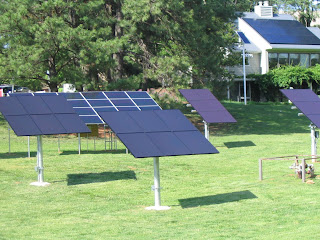On May 2, 2011 I went to the Solar House next to the McKimmon Center off of Western Blvd and Gorman Street. As an Environmental Technology student, it was surprising that this was my first trip to the Solar House. My professors have mentioned the Solar House numerous times, but I have never made the actual trip out and across the street.
The house is roughly 2150 square feet, including a balcony, sunroom, and garage. It is entirely powered by solar panels on the house. The garage also has solar cells on it to generate power for the structure and an electric hybrid car. Below is a picture of the garage, and the roof that is covered with solar cells. There is also another picture of a toy from 1998. The hot wheels car contains a small solar panel on it that is “guaranteed for life.” The toy demonstrates how mainstream and “old” solar energy was then and is today.


Surrounding the Solar House, there are free standing solar panels and windmills that are used for research by various colleges and researchers on campus. The solar panels and windmills do not contribute to generate power for the Solar House, which I and other visitors originally thought. From the tour, I also learned about the energy savings and energy credits the Solar House gets from Progress Energy. Overall, I think the Solar House is a good advertisement for alternative energy, and a nearby educational resource for people to see how alternative energy does mean sacrifices have to be made as far as home design.



















 s if you need them and all sorts of different view points to look at, such as a patio section, as well as a walking bridge. Depending on which trail you take, you are able to see all sorts of different species around. The cool thing that they have is that there are different numbers at different sections of each trail that tell you what to expect there, like different plants/trees or animals. The Swift Creek Loop trail primarily shows you a great assortment of plants, trees, and shrubs. The Chestnut Oak Loop Trail, which is over a mile long, has more of the wildlife. When walking both of these trails, I realized that it's literally a breeze! I mean, I really didn't notice how long each was because everywhere I looked, there was always something that caught my eye. Even if you didn't like the we
s if you need them and all sorts of different view points to look at, such as a patio section, as well as a walking bridge. Depending on which trail you take, you are able to see all sorts of different species around. The cool thing that they have is that there are different numbers at different sections of each trail that tell you what to expect there, like different plants/trees or animals. The Swift Creek Loop trail primarily shows you a great assortment of plants, trees, and shrubs. The Chestnut Oak Loop Trail, which is over a mile long, has more of the wildlife. When walking both of these trails, I realized that it's literally a breeze! I mean, I really didn't notice how long each was because everywhere I looked, there was always something that caught my eye. Even if you didn't like the we



























